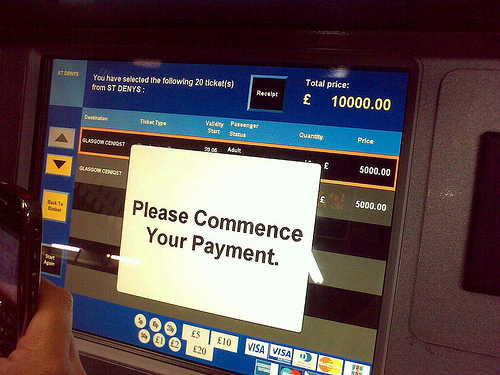What could you do with open railway data?

Let me show you a great way to get more people using the train.
Let’s say railway timetable and live running information was available under an open data licence. Anyone could download it, anyone could use it.
Ok, sounds a bit abstruse. So let’s ask: if you were a developer, what would you do with this data?
- Google could integrate the data into Google Transit, so when people asked for driving directions on Google Maps, they’d find out how easy it is to use the train instead. WIN.
- CycleStreets could mash it up with OpenStreetMap’s excellent cycle route data, so you could easily plan a journey from any point to any point by bike and train. No need for the car. WIN.
- Designers could make a lovely animation of trains running around the place. Animations are cool. If more people think trains are cool, more people will catch the train. WIN.
- Walking route websites could use the data to encourage station-to-station walks on little rural branch lines which don’t have many trains per day. If people can be reassured the walk will get them to the train at the right time, they’ll be less likely to drive the car all over the sensitive National Park “just in case”. WIN.
- iPhone or Android developers could create a super app that figures that your train is running a bit late, and magically replans all your connections for you, telling you where you need to change and what platform to head to. If train delays are less traumatic, people will be more likely to use the train. WIN.
- Another super mobile app idea: let people record how busy the train they’re on is. So you could use the app to record “I’m on the 17.22 from Paddington and I can’t find anywhere to sit”. All these reports would be aggregated (‘crowdsourcing’), mashed up against the timetable, and fed into a journey-planner - which could then offer you an “Avoid busy trains” tickbox. Which would be fantastic for both passengers and for the train companies who want to spread the load out. WIN.
- Companies could put little “get here by train” widgets on the “contact us” page on their website. Business travel by train is good. You can work on the train. You can’t work in the car. WIN.
- Village websites could integrate the live departure board onto their main page. (I’d love to do this with the Charlbury website.) That way, people who were about to hop into the car could see there’s a train in a few minutes, and get that instead. And bleary-eyed people like my little sister, who gets the 6am train every morning, could have an extra 10 minutes’ toast-eating if it was running late. WIN.
- Rail passengers’ websites could keep track of punctuality for particular trains. That way, if a grumpy petrolhead boss says “you’re not getting the train any more, it’s always late”, you could point and say “actually, it runs to time almost every day”. Or if one train does always run late, you could plan your journey around it. WIN.
- Journey-planning websites could specialise in particular users. A website for older passengers might avoid changing trains where there’s lots of stairs (e.g. Birmingham New Street) and suggest easier ones (e.g. Wolverhampton) instead. Or one for people like me who walk too fast could offer five-minute connections instead of ten-minute ones. WIN.
These are just ten ideas off the top of my head. But the beauty of releasing data openly is that thousands of people have their own ten ideas. They will build them. Thousands of people x ten ideas x WIN = lots more people using the train, not the car.
And that’s why train companies should release their timetable and train running information as free, open data. At present they sell the data. That’s short-sighted. The small income they get from selling it would be greatly outweighed by all this WIN leading to more people buying train tickets. To say nothing of the environmental benefits...
The Government has already made encouraging noises, but nothing’s happened yet. But, happy day, the Office of Rail Regulation has a consultation out on “giving passengers the information they need to plan and make journeys”. It doesn’t say the data will be released openly. It should.
Here's what I've written in response. It would be lovely if ORR saw a blinding flash of enlightenment as a result, but it’s pretty unlikely to come if just one person writes to them. So if you like this, if you think there might be more ideas - you might even have ten yourself - then write to tell them.
You can do this by e-mailing abigail.grenfell@orr.gsi.gov.uk. The deadline is Monday 20th June. There are lots of specifics in the consultation document, and you should read them if you can. But it all comes down to this, from near the start of the document: “how the industry provides information, including what obligations operators have to meet their customers' needs, and whether there are any gaps that should be filled”.
I think the best way to get these gaps filled is to release the data openly, so anyone can fill them. If you agree, write and tell them.
Photo by Tom at flickr.com, CC-BY-NC-SA.
Posted on Friday 13 May 2011. Link.